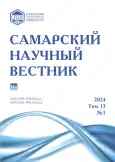Сравнительные данные о лейкоцитарном составе крови черепах с полуводным образом жизни из Самарского зоопарка
- Авторы: Романова Е.Б.1, Столярова И.А.1, Бакиев А.Г.2, Горелов Р.А.2
-
Учреждения:
- Национальный исследовательский Нижегородский государственный университет им. Н.И. Лобачевского
- Институт экологии Волжского бассейна РАН – филиал Самарского федерального исследовательского центра РАН
- Выпуск: Том 13, № 1 (2024)
- Страницы: 44-53
- Раздел: Биологические науки
- URL: https://journals.rcsi.science/2309-4370/article/view/263411
- DOI: https://doi.org/10.55355/snv2024131106
- ID: 263411
Цитировать
Полный текст
Аннотация
Определены лейкоцитарные формулы крови 16 видов пяти семейств черепах, ведущих полуводный образ жизни, из Самарского зоопарка. При сравнении лейкограмм представителей двух родов семейства Emydidae выявлены пониженная доля гетерофилов и повышенная доля базофилов у Graptemys (G. pseudogeographica, G. nigrinoda) по сравнению с Terrapene (T. triunguis, T. ornata). Лейкоцитарный профиль Cuora mouhotii (Geoemydidae) отличался повышенным содержанием гетерофилов, что показывало более высокую активацию врожденных иммунных реакций. Наиболее сходны по лейкоцитарному составу виды семейства Kinosternidae из трех родов: Kinosternon, Sternotherus и Staurotypus. Инфраотряд Trionychia (Trionychidae) отличался от инфраотряда Durocryptodira (Emydidae, Geoemydidae и Kinosternidae) повышенным количеством гетерофилов и моноцитов, невысоким содержанием эозинофилов. Подотряд Pleurodira (Chelidae) отличался от подотряда Cryptodira (Emydidae, Geoemydidae, Kinosternidae, Trionychidae) повышенным содержанием агранулоцитов. Выявлены отражающие усиление роли неспецифической резистентности организма черепах в ходе онтогенеза положительные значимые корреляции длины карапакса с содержанием гетерофилов и значениями лейкоцитарных индексов (соотношения лимфоцитов и эозинофилов, гетерофилов и эозинофилов, гетерофилов и лимфоцитов), отрицательные значимые корреляции с содержанием эозинофилов. Соотношение гетерофилов и лимфоцитов, являющееся показателем физиологического стресса, имело минимальное среди исследованных видов значение у Sternotherus odoratus (Kinosternidae), максимальное значение – у C. mouhotii (Geoemydidae).
Ключевые слова
Полный текст
Открыть статью на сайте журналаОб авторах
Елена Борисовна Романова
Национальный исследовательский Нижегородский государственный университет им. Н.И. Лобачевского
Автор, ответственный за переписку.
Email: romanova@ibbm.unn.ru
доктор биологических наук, профессор кафедры экологии
Россия, г. Нижний НовгородИрина Александровна Столярова
Национальный исследовательский Нижегородский государственный университет им. Н.И. Лобачевского
Email: irinaisto75@gmail.com
магистрант кафедры экологии
Россия, г. Нижний НовгородАндрей Геннадьевич Бакиев
Институт экологии Волжского бассейна РАН – филиал Самарского федерального исследовательского центра РАН
Email: herpetology@list.ru
кандидат биологических наук, старший научный сотрудник лаборатории биоразнообразия
Россия, г. Тольятти, Самарская областьРоман Андреевич Горелов
Институт экологии Волжского бассейна РАН – филиал Самарского федерального исследовательского центра РАН
Email: gorelov.roman@mail.ru
кандидат биологических наук, младший научный сотрудник лаборатории биоразнообразия
Россия, г. Тольятти, Самарская областьСписок литературы
- Krenz J.G., Naylor G.J.P., Shaffer H.B., Janzen F.J. Molecular phylogenetics and evolution of turtles // Molecular Phylogenetics and Evolution. 2005. Vol. 37, iss. 1. P. 178–191. doi: 10.1016/j.ympev.2005.04.027.
- Barley A.J., Spinks P.Q., Thomson R.C., Shaffer H.B. Fourteen nuclear genes provide phylogenetic resolution for difficult nodes in the turtle tree of life // Molecular Phylogenetics and Evolution. 2010. Vol. 55, iss. 3. P. 1189–1194. doi: 10.1016/j.ympev.2009.11.005.
- Crawford N.G., Parham J.F., Sellas A.B., Faircloth B.C., Glenn T.C., Papenfuss T.J., Henderson J.B., Hansen M.H., Simison W.B. A phylogenomic analysis of turtles // Molecular Phylogenetics and Evolution. 2015. Vol. 83. P. 250–257. doi: 10.1016/j.ympev.2014.10.021.
- Shaffer H.B., McCartney-Melstad E., Near T.J., Mount G.G., Spinks P.Q. Phylogenomic analyses of 539 highly informative loci dates a fully resolved time tree for the major clades of living turtles (Testudines) // Molecular Phylogenetics and Evolution. 2017. Vol. 115. P. 7–15. doi: 10.1016/j.ympev.2017.07.006.
- Lyson T.R., Bever G.S. Origin and evolution of the turtle body plan // Annual Review of Ecology, Evolution, and Systematics. 2020. Vol. 51. P. 143–166. doi: 10.1146/annurev-ecolsys-110218-024746.
- Черепахи // Биологический энциклопедический словарь. М.: Советская энциклопедия, 1986. С. 713–714.
- The Reptile Database / eds. P. Uetz, P. Freed, R. Aguilar, F. Reyes, J. Kudera, J. Hošek. 2024 [Internet]. http://www.reptile-database.org.
- Agha M., Ennen J.R., Bower D.S., Nowakowski A.J., Sweat S.C., Todd B.D. Salinity tolerances and use of saline environments by freshwater turtles: Implications of sea level rise // Biological Reviews of the Cambridge Philosophical Society. 2018. Vol. 93. P. 1634–1648. doi: 10.1111/brv.12410.
- International Guiding Principles for Biomedical Research Involving Animals. 2012 [Internet]. https://grants.nih.gov/grants/olaw/guiding_principles_2012.pdf.
- Alleman A.R., Jacobson E.R., Raskin R.E. Morphologic and cytochemical characteristics of blood cells from the desert tortoise (Gopherus agassizii) // American Journal of Veterinary Research. 1992. Vol. 53, iss. 9. P. 1645–1651.
- Соколина Ф.М., Павлов А.В., Юсупов Р.Х. Гематология пресмыкающихся: метод. пособие по курсу герпетология, большому практикуму и спецсеминарам. Казань: Казанский государственный университет, 1997. 31 с.
- Хайрутдинов И.З., Соколина Ф.М. Характеристика крови рептилий и ее связь с условиями обитания: учеб.-метод. пособие к курсу «Герпетология». Казань: Казанский университет, 2010. 44 с.
- Davis A.K., Maney D.L., Maerz J.C. The use of leukocyte profiles to measure stress in vertebrates: A review for ecologists // Functional Ecology. 2008. Vol. 22, iss. 5. P. 760–772. doi: 10.1111/j.1365-2435.2008.01467.x.
- Minias P. Evolution of heterophil/lymphocyte ratios in response to ecological and life-history traits: A comparative analysis across the avian tree of life // Journal of Animal Ecology. 2019. Vol. 88, iss. 4. P. 554–565. doi: 10.1111/1365-2656.12941.
- Kogut M.H., Iqbal M., He H., Philbin V., Kaiser P., Smith A. Expression and function of Toll-like receptors in chicken heterophils // Developmental & Comparative Immunology. 2005. Vol. 29, iss. 9. P. 791–807. doi: 10.1016/j.dci.2005.02.002.
- Hasselquist D. Comparative immunoecology in birds: hypotheses and tests // Journal of Ornithology. 2007. Vol. 148. P. 571–582. doi: 10.1007/s10336-007-0201-x.
- Reinke B.A., Cayuela H., Janzen F.J. et al. Diverse aging rates in ectothermic tetrapods provide insights for the evolution of aging and longevity // Science. 2022. Vol. 376, iss. 6600. P. 1459–1466. doi: 10.1126/science.abm0151.
- Hoebe K., Janssen E., Beutler B. The interface between innate and adaptive immunity // Nature Immunology. 2004. Vol. 5. P. 971–974. doi: 10.1038/ni1004-971.
- Lee K.A. Linking immune defenses and life history at the levels of the individual and the species // Integrative and Comparative Biology. 2006. Vol. 46, iss. 6. P. 1000–1015. doi: 10.1093/icb/icl049.
Дополнительные файлы












